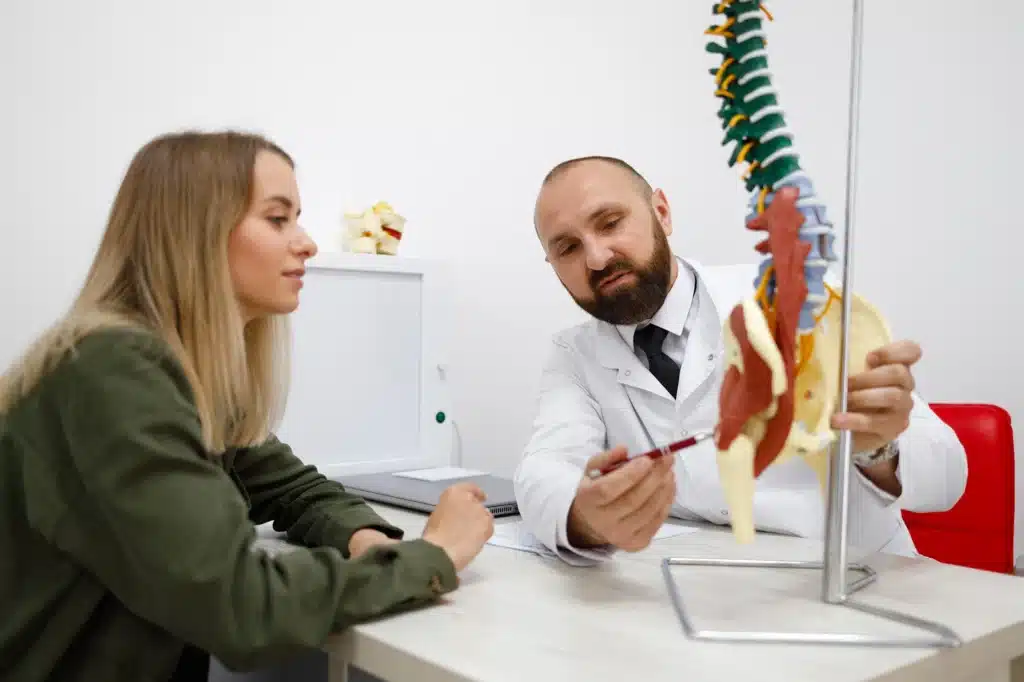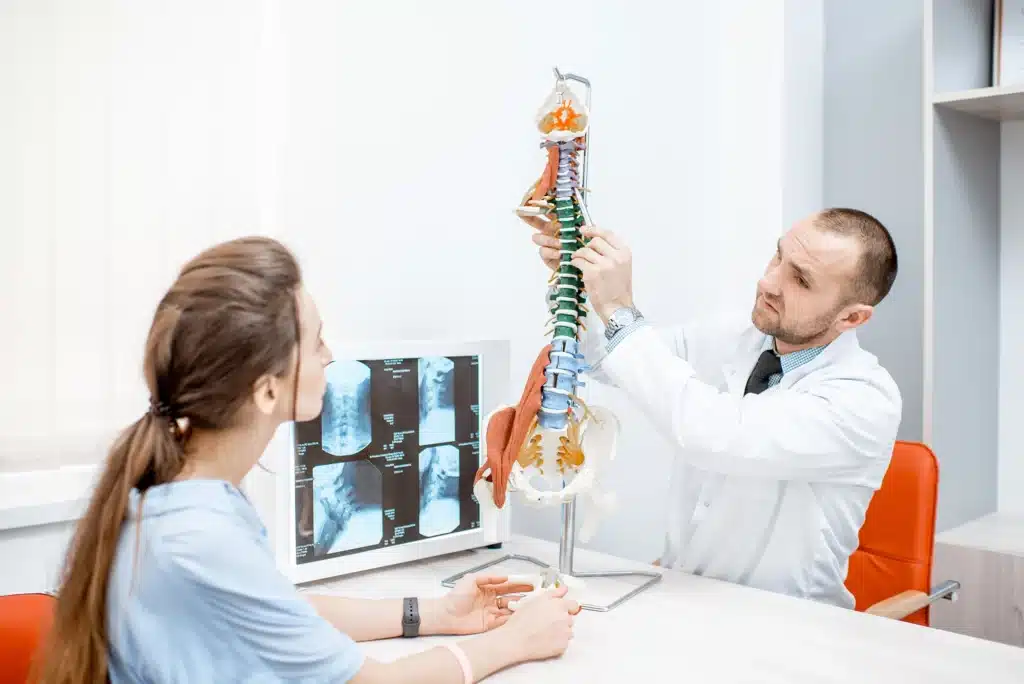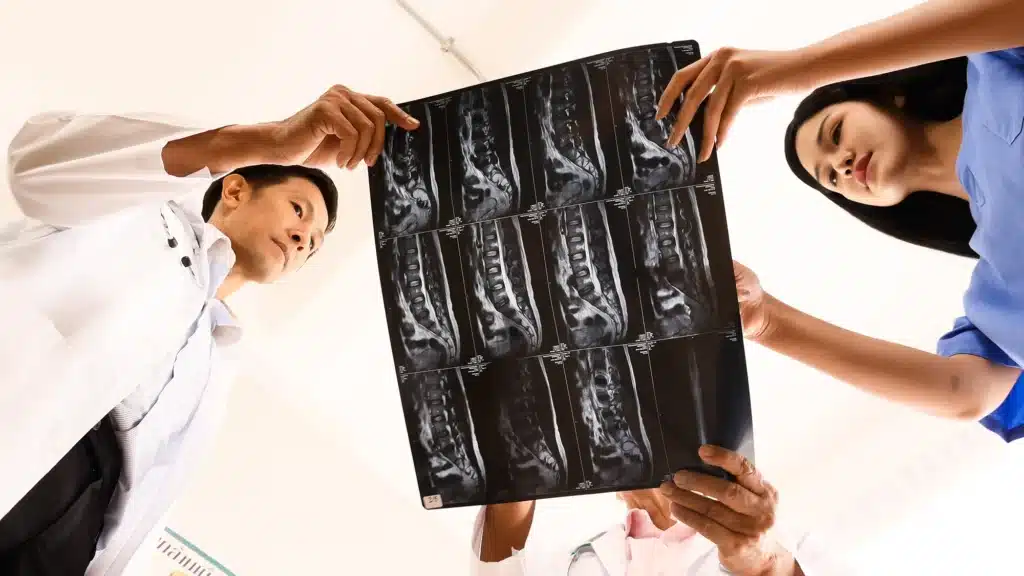
Table of Contents
ToggleMinimally invasive spine surgery (MISS) is a modern approach to spinal surgery that uses smaller incisions and causes less damage to surrounding muscles and tissues compared to traditional open surgery. This technique allows surgeons to stabilize vertebral bones and joints or relieve pressure on spinal nerves caused by conditions such as spinal instability, bone spurs, herniated discs, scoliosis, or spinal tumors.
At Long Island Neuroscience Specialists, we leverage advanced technology and our extensive experience in brain and spine surgery to offer our patients the best possible outcomes with minimally invasive spine surgery.

There are numerous benefits to minimally invasive spine surgery over traditional methods. Firstly, patients experience better cosmetic results due to smaller skin incisions, sometimes as small as a few millimeters.
This also leads to less blood loss during surgery, reducing the risk of complications. Since there is less or no cutting of the muscle, the risk of muscle damage is significantly reduced. Consequently, patients often experience less postoperative pain and a quicker recovery time.
Moreover, with minimally invasive spine surgery, there is a reduced reliance on pain medications post-surgery, allowing for a smoother and faster rehabilitation process. In some cases, these procedures can be performed on an outpatient basis using only local anesthesia, which lowers the risk of adverse reactions to general anesthesia.
Minimally invasive spine surgery is versatile and can treat a variety of conditions. One common condition is degenerative disc disease, where the spinal discs deteriorate and cause pain.
Herniated discs, where the disc material presses on nearby nerves, can also be treated with MISS. Lumbar spinal stenosis, a narrowing of the spinal canal that puts pressure on the nerves, is another condition that benefits from this approach.
Additionally, spinal deformities such as scoliosis, which causes a sideways curvature of the spine, can be corrected using minimally invasive techniques. Other conditions include spinal infections, spinal instability like spondylolisthesis (where one vertebra slips over another), vertebral compression fractures, and spinal tumors.
Performing minimally invasive spine surgery involves several specialized techniques. Typically, the surgeon makes a small incision and inserts a tubular retractor to create a tunnel to the spine.
This method avoids cutting through muscles, instead gently pushing them aside. The surgeon can then use small tools to access the spine through this retractor.
Advanced imaging techniques, such as real-time X-rays (fluoroscopy) and operating microscopes, help the surgeon view the area clearly during the procedure. Techniques like percutaneous placement of screws and rods can stabilize the spine without large incisions.
In some cases, endoscopic methods, where a small camera is used, allow for even less invasive access to the spine. These innovative methods are what enable us to achieve excellent outcomes at Long Island Neuroscience Specialists.
To explore the various spinal surgery procedures we offer, learn more about our spinal surgery procedures.

Recovery from minimally invasive spine surgery is typically faster and less painful than recovery from traditional spine surgery. Many patients can go home the same day or within 1 to 2 days after the procedure, while traditional surgery might require a hospital stay of 3 to 5 days.
Postoperative pain is usually less severe due to the minimal disruption of muscles and tissues, although some discomfort is still expected. Pain management strategies include medications, cold packs, and gentle walking.
Physical therapy is often recommended to help regain strength and mobility. The specific recovery time can vary depending on the individual and the type of surgery performed, but many patients return to normal activities much quicker than they would after traditional surgery.
It’s important to follow all postoperative instructions and attend follow-up appointments to ensure a smooth recovery.
As with any surgical procedure, minimally invasive spine surgery carries certain risks. Potential complications include infection, excessive bleeding, and nerve damage.
Although rare, there is also a risk of blood clots forming in the legs (deep vein thrombosis), which can be dangerous if they travel to the lungs. Another possible complication is a spinal fluid leak, which can cause headaches and other issues.
Additionally, not all patients experience complete relief from their symptoms, and in some cases, a second surgery might be necessary. The risks of anesthesia, whether general or regional, should also be considered.
However, choosing an experienced surgeon and a well-equipped facility can significantly reduce these risks. At Long Island Neuroscience Specialists, we prioritize patient safety and take every precaution to minimize potential complications.

Not everyone with a spinal condition is a candidate for minimally invasive spine surgery. The decision to proceed with MISS depends on various factors, including the type and severity of the spinal issue, the patient’s overall health, and previous treatments tried.
Typically, surgery is only recommended after nonsurgical treatments, such as medications and physical therapy, have failed to relieve symptoms. Diagnostic tests like X-rays, MRIs, or CT scans are used to pinpoint the exact source of pain and determine if it can be addressed with MISS. Conditions like herniated discs, spinal stenosis, and certain deformities are often treatable with minimally invasive techniques.
However, more complex issues may still require traditional open surgery. Consulting with a spine specialist is essential to evaluate if MISS is the right option for you.
Selecting the right surgeon and facility is crucial for the success of minimally invasive spine surgery. Look for surgeons who are board-certified and have specialized training in MISS techniques.
Experience is key; a surgeon who has performed many minimally invasive procedures is more likely to achieve better outcomes. It’s also important to choose a facility equipped with the latest technology, such as advanced imaging systems and robotic assistance, which are essential for these precise procedures.
At Long Island Neuroscience Specialists, our team of highly skilled surgeons has extensive experience in minimally invasive spine surgery, supported by state-of-the-art facilities. We are committed to providing personalized care and achieving the best possible results for our patients.
The cost of minimally invasive spine surgery can vary depending on several factors, including the specific procedure, the surgeon’s fees, and the facility charges. Generally, MISS can be more cost-effective in the long run due to shorter hospital stays and quicker recovery times, which reduce the need for extended rehabilitation and time off work.
While the initial cost may be comparable to traditional surgery, the overall financial burden is often lower. Insurance coverage is also an important consideration; many insurance plans cover minimally invasive procedures, but it’s essential to verify this with your provider.
At Long Island Neuroscience Specialists, we work with patients to navigate the financial aspects and ensure they receive the care they need without unnecessary stress.

Hearing from patients who have undergone minimally invasive spine surgery can provide valuable insights and reassurance. Many of our patients at Long Island Neuroscience Specialists have shared their positive experiences and the significant improvements in their quality of life post-surgery.
For example, one patient with a herniated disc reported being able to return to work within weeks and experiencing far less pain than expected. Another patient who underwent spinal fusion for scoliosis was thrilled with the faster recovery and minimal scarring.
These success stories highlight the effectiveness of minimally invasive techniques and the high level of care provided by our team. Reading about others’ experiences can help you feel more confident and informed about your decision to pursue MISS.
Minimally invasive spine surgery has significantly benefited from advancements in medical technology. At Long Island Neuroscience Specialists, we utilize state-of-the-art equipment to ensure precision and enhance patient outcomes.
One key technology is the operating microscope, which provides excellent illumination and magnification, allowing surgeons to see intricate structures clearly. High-resolution cameras and real-time X-rays (fluoroscopy) guide the surgeon throughout the procedure, ensuring accurate placement of instruments and implants.
Robotic assistance is another groundbreaking advancement. Robotic systems help surgeons perform complex maneuvers with greater accuracy and control, reducing the risk of complications.
These systems use detailed imaging to create a 3D map of the patient’s spine, enabling precise navigation during surgery. Additionally, computer-assisted navigation tools offer real-time feedback and enhanced visualization, making surgeries safer and more efficient.
These technological advancements not only improve the safety and effectiveness of minimally invasive spine surgery but also contribute to shorter recovery times and better overall patient experiences. Our commitment to using the latest technology reflects our dedication to providing the highest standard of care.
Every patient is unique, and so is their spinal condition. At Long Island Neuroscience Specialists, we believe in creating personalized treatment plans tailored to each patient’s specific needs.
The process begins with a thorough evaluation, including a detailed medical history, physical examination, and advanced imaging studies. This comprehensive assessment helps us understand the root cause of the patient’s symptoms and determine the most appropriate surgical approach.
Once we have a clear diagnosis, we discuss the treatment options with the patient, explaining the benefits and risks of minimally invasive spine surgery. We consider factors such as the patient’s age, overall health, activity level, and personal preferences.
Our goal is to ensure that the patient is well-informed and comfortable with their treatment plan.
Collaboration with other healthcare professionals, such as physical therapists and pain management specialists, is also crucial in developing a holistic treatment strategy. This multidisciplinary approach ensures that all aspects of the patient’s health are addressed, leading to better surgical outcomes and improved quality of life.

Rehabilitation plays a vital role in the recovery process after minimally invasive spine surgery. At Long Island Neuroscience Specialists, we emphasize the importance of a well-structured rehabilitation program to help patients regain strength and mobility.
Early mobilization is encouraged, with patients typically beginning gentle exercises and walking soon after surgery.
Physical therapy is a cornerstone of post-surgery rehabilitation. A personalized therapy plan is designed to address the specific needs of each patient.
This plan may include exercises to improve flexibility, strengthen the core and back muscles, and enhance overall stability. The therapist works closely with the patient to ensure they perform the exercises correctly and safely.
Education is another critical component. Patients are taught how to move, sit, stand, and lift properly to protect their spine and avoid re-injury.
They also learn about ergonomics and lifestyle modifications to support their recovery and long-term spinal health. Regular follow-up appointments allow us to monitor progress and adjust the rehabilitation plan as needed, ensuring a smooth and successful recovery.
While both minimally invasive spine surgery and traditional open surgery aim to treat spinal conditions effectively, there are significant differences between the two approaches. Traditional open surgery involves large incisions and extensive muscle retraction, which can lead to increased pain, longer hospital stays, and extended recovery times.
In contrast, minimally invasive techniques use smaller incisions and cause less disruption to the surrounding tissues.
One of the main advantages of minimally invasive spine surgery is the reduced risk of complications. Smaller incisions mean less blood loss and a lower risk of infection.
Patients also experience less postoperative pain, which reduces the need for strong pain medications and their associated side effects. This can lead to a quicker return to normal activities and a higher overall satisfaction rate.
Another key difference is the cosmetic outcome. Minimally invasive surgery results in smaller scars, which is often a significant consideration for patients concerned about the aesthetic impact of their surgery. Additionally, the reduced muscle damage associated with minimally invasive techniques can help preserve muscle function and strength, leading to better long-term outcomes.
For a broader understanding of advanced spine surgery techniques, read about advanced spine surgery techniques at the Mayo Clinic.
Preparation is crucial for the success of minimally invasive spine surgery. At Long Island Neuroscience Specialists, we guide our patients through every step of the preparation process.
Before surgery, patients undergo a series of evaluations, including imaging studies and blood tests, to ensure they are in optimal condition for the procedure.
Patients are advised to stop taking certain medications, such as blood thinners, a few days before surgery to reduce the risk of excessive bleeding. If the patient smokes, we strongly encourage them to quit, as smoking can impair healing and increase the risk of complications.
Nutritional advice may also be provided to boost the patient’s immune system and overall health before surgery.
Mental preparation is equally important. Understanding what to expect during and after surgery can help alleviate anxiety and ensure a smoother recovery.
We take the time to answer any questions and address concerns, ensuring that our patients feel confident and well-informed. On the day of surgery, patients are given specific instructions regarding fasting and medication use to ensure they are fully prepared for the procedure.

The long-term success of minimally invasive spine surgery depends not only on the procedure itself but also on the quality of follow-up care. At Long Island Neuroscience Specialists, we prioritize comprehensive follow-up care to ensure our patients achieve the best possible outcomes.
Regular check-ups allow us to monitor the healing process, address any concerns, and make necessary adjustments to the recovery plan.
Patients are encouraged to maintain a healthy lifestyle, including regular exercise and proper nutrition, to support their spinal health. We provide ongoing education on spine care and ergonomics to help prevent future issues.
For some patients, periodic physical therapy sessions may be recommended to maintain flexibility and strength.
We also emphasize the importance of reporting any new or recurring symptoms promptly. Early detection of potential problems allows for timely intervention, which can prevent complications and ensure a better quality of life. Our commitment to long-term care reflects our dedication to our patients’ well-being and our goal of achieving lasting improvements in their spinal health.
At Long Island Neuroscience Specialists, we value patient feedback and use it to continuously improve our services. After minimally invasive spine surgery, we actively seek feedback from our patients about their experiences, from the initial consultation to the recovery phase.
This feedback helps us identify areas for improvement and implement changes to enhance patient satisfaction and outcomes.
We also stay abreast of the latest advancements in spinal surgery through ongoing education and training. Our surgeons regularly attend conferences, participate in research, and collaborate with other experts in the field to stay updated on the newest techniques and technologies.
This commitment to continuous improvement ensures that we provide our patients with the highest quality care using the most advanced methods available.
By integrating patient feedback and staying current with medical advancements, we strive to maintain our position as leaders in minimally invasive spine surgery. Our dedication to excellence and patient-centered care sets us apart and ensures that our patients receive the best possible treatment for their spinal conditions.
The field of minimally invasive spine surgery is constantly evolving, with new techniques and technologies continually being developed. At Long Island Neuroscience Specialists, we are excited about the future and committed to being at the forefront of these advancements.
Emerging technologies such as augmented reality (AR) and artificial intelligence (AI) are poised to revolutionize spine surgery by enhancing precision and reducing the risk of complications.
Augmented reality can provide surgeons with detailed, real-time visualizations of the spinal anatomy, allowing for even more precise surgical interventions. AI algorithms can analyze vast amounts of data to assist in preoperative planning, predicting outcomes, and personalizing treatment plans.
These technologies have the potential to make minimally invasive spine surgery safer, more effective, and accessible to a broader range of patients.
As we look to the future, our focus remains on providing the best possible care for our patients. We are committed to adopting innovative techniques and technologies that enhance patient outcomes and improve the overall surgical experience.
By staying at the cutting edge of medical advancements, we aim to continue delivering exceptional care and helping our patients achieve better spinal health.

Patient education is a cornerstone of successful outcomes in minimally invasive spine surgery. At Long Island Neuroscience Specialists, we believe that informed patients are empowered to make the best decisions about their health.
From the initial consultation through postoperative care, we prioritize clear, open communication to ensure that patients understand every aspect of their treatment.
During the consultation, we provide detailed explanations of the diagnosis, the recommended surgical procedure, and the expected outcomes. We also discuss potential risks and complications, helping patients weigh the benefits and make informed choices.
Educational materials, such as brochures and videos, supplement our verbal explanations, offering patients additional resources to review at their own pace.
Patient involvement extends beyond the decision-making process. We encourage patients to actively participate in their recovery by following postoperative instructions, attending physical therapy sessions, and adhering to lifestyle recommendations.
By fostering a collaborative relationship, we help patients achieve the best possible results from their minimally invasive spine surgery.
Research and development play a critical role in advancing the field of spine surgery. At Long Island Neuroscience Specialists, we are dedicated to contributing to the ongoing research that drives innovation in minimally invasive techniques.
Our surgeons are actively involved in clinical trials and studies that explore new surgical methods, improve existing procedures, and enhance patient outcomes.
Collaboration with leading research institutions allows us to stay at the forefront of medical advancements. Through these partnerships, we gain access to the latest technologies and techniques, ensuring that our patients benefit from cutting-edge treatments.
Our commitment to research not only advances the field but also improves the quality of care we provide to our patients.
Continued investment in research and development is essential for the future of minimally invasive spine surgery. By pushing the boundaries of what is possible, we strive to make these advanced procedures more effective, safer, and accessible to all patients suffering from spinal conditions.
Long Island Neuroscience Specialists is more than just a medical practice; we are a vital resource for the community. We offer educational seminars and workshops to inform the public about the benefits of minimally invasive spine surgery and other spinal health topics.
These events provide an opportunity for individuals to learn directly from our expert surgeons and ask questions in a supportive environment.
Our outreach efforts extend to local schools, senior centers, and community organizations, where we provide presentations on spine health, injury prevention, and the latest advancements in spine surgery. By engaging with the community, we aim to raise awareness about spinal health and the options available for treating spinal conditions.
Additionally, our website serves as an extensive resource for patients and their families. It features detailed information on various spinal conditions, treatment options, and what to expect before, during, and after surgery.
By providing comprehensive online resources, we help individuals make informed decisions about their spine health from the comfort of their homes.

Hearing from patients who have undergone minimally invasive spine surgery can be incredibly reassuring for those considering the procedure. At Long Island Neuroscience Specialists, we are proud of the positive feedback we receive from our patients, whose lives have been transformed by our care.
One of our patients, John, suffered from severe lumbar spinal stenosis that limited his mobility and caused constant pain. After undergoing minimally invasive spinal decompression, John experienced significant relief and was able to return to his active lifestyle within weeks.
He praises the minimal scarring and the quick recovery, attributing his successful outcome to the expertise of our surgical team.
Another patient, Maria, had a herniated disc that caused debilitating leg pain. She underwent a minimally invasive discectomy and was amazed at how quickly she recovered.
Maria was able to resume her daily activities much sooner than expected and appreciated the compassionate care she received throughout the process.
These testimonials highlight the effectiveness of minimally invasive spine surgery and the difference it can make in patients’ lives. By sharing these real stories, we hope to provide insight and encouragement to others who are exploring their treatment options.
Minimally invasive spine surgery represents a significant advancement in the treatment of spinal conditions, offering numerous benefits over traditional open surgery. At Long Island Neuroscience Specialists, we are dedicated to providing this cutting-edge care, utilizing the latest technologies and personalized treatment plans to achieve the best possible outcomes for our patients.
From the initial consultation through recovery and follow-up care, we prioritize patient education, safety, and satisfaction. Our team of experienced surgeons and healthcare professionals is committed to delivering high-quality care that meets the unique needs of each patient.
Whether you are dealing with a herniated disc, spinal stenosis, or another spinal condition, minimally invasive spine surgery may offer the relief you need with a faster recovery and less pain.
We invite you to learn more about our services and explore the possibilities of minimally invasive spine surgery. Contact Long Island Neuroscience Specialists today to schedule a consultation and take the first step toward a healthier, pain-free life.
GET IN TOUCH +
285 Sills Road
Building 5-6, Suite E
East Patchogue, NY 11772
(631) 475-5511
184 N. Belle Mead Road
East Setauket, NY 11733
(631) 675-6226
GET IN TOUCH +
285 Sills Road
Building 5-6, Suite E
East Patchogue, NY 11772
(631) 475-5511
184 N. Belle Mead Road
East Setauket, NY 11733
(631) 675-6226
SUBSCRIBE TO OUR NEWSLETTER +
Send us a Google review. Click this link and let us know how we did!
Review us on Yelp too.